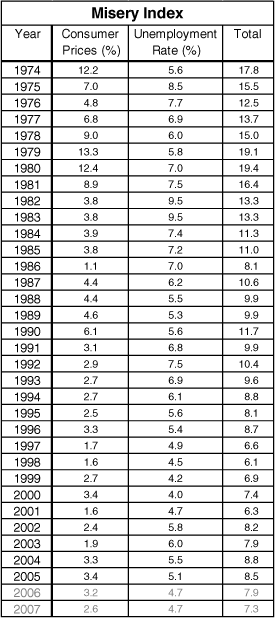|
October 4, 2006
Misery
Written by Jeff Thredgold, CSP, President, Thredgold Economic Associates
Note: With five speaking presentations this week in Virginia, Connecticut, and in Alabama, I thought it might be of interest to review a history of “the misery index”…a political tool that had great significance in prior Presidential elections.
One of the major political issues that greatly impacted results of U.S. Presidential elections during 1976 and 1980 was frequent reference to “the misery index.” This so-called “index” was simply the sum of the nation’s most recent Unemployment Rate and the rise in the nation’s Consumer Price Index for the most recent 12-month period. This combination was a simple way to measure the level of “pain” or “misery” of the American people when it came to the overall level of joblessness and the loss of purchasing power due to rising inflation.
The misery index was first made politically newsworthy by Democratic Presidential Candidate Jimmy Carter in 1976. During the Presidential election of that year, Mr. Carter constantly attacked President Gerald Ford for his mishandling of the American economy.
Candidate Carter frequently noted during the campaign that the misery index was in the mid-teens, as compared to much lower levels during the 1950s, 1960s, and early 1970s. Mr. Carter’s criticism of President Ford’s economic mismanagement was effective, helping him defeat the incumbent Republican President during the November 1976 election.
“What Goes Around…”
As the saying goes, however…“what goes around, comes around” (or something like that). During the 1980 Presidential campaign four years later, Republican Candidate Ronald Reagan constantly made reference to President Carter’s economic failings, primarily as measured by “you know what.”
By November 1980, the misery index had moved even higher, with several monthly measurements above 20. Candidate Reagan’s constant battering of President Carter with his own index was also very effective, as Ronald Reagan handily defeated the incumbent Democratic President.
 References to the misery index have clearly waned in recent years, although it remains a reasonable—if simplistic—measure of American consumer economic well being. As the graph indicates, the U.S. made enormous progress in reducing this particular measure of consumer pain, especially during the decade of the 1990s. References to the misery index have clearly waned in recent years, although it remains a reasonable—if simplistic—measure of American consumer economic well being. As the graph indicates, the U.S. made enormous progress in reducing this particular measure of consumer pain, especially during the decade of the 1990s.
The Numbers
On the employment side of the equation, impressive U.S. economic growth and resultant strong job creation during much of the past 10 years led the nation’s unemployment rate to average 4.1% during calendar years 1999 and 2000, its lowest annual average in 30 years. The nation’s unemployment rate actually fell slightly below 4.0% during various months in 2000, the lowest monthly rate since January 1970. While true, one actually has to go back to the mid-1950s to find a peacetime unemployment rate as low as 3.9%.
More recently, the nation’s unemployment rate again declined from the near 6.0% average following the mild 2000-2001 recession. The 4.7% average expected in 2006 will be its lowest average level in five years.
On the inflation side, 1) fierce domestic and global competition in nearly every major industry, 2) more aggressive actions by consumers to resist price increases, 3) more effective corporate utilization of technology, and 4) the inflation fighting nature of the Internet saw inflation pressures remain modest in the first few years of the 21st Century.
The escalation of numerous commodity prices in recent years led inflation pressures higher. Global prices for oil, steel, copper, lead, aluminum, etc., tied in part to sharply rising demand from China and India, led overall inflation pressures higher. Such upward pressure on commodity prices was a key ingredient in the Federal Reserve’s elongated monetary tightening program of June 2004 through June 2006.
Bottomed Out?
Has the misery index bottomed?…Very likely. The nation’s unemployment rate dipped to extremely low levels in 1998-2000. This decline was particularly impressive in light of frequent cost reduction and layoff programs regularly announced by prominent U.S. companies during the past decade. Inflation pressures were also largely muted during 1997 to 2003. The misery index will enter the history books as an interesting political footnote.

“Tea”ser
Things are more like they are now than they have ever been.
—Gerald R. Ford
|

